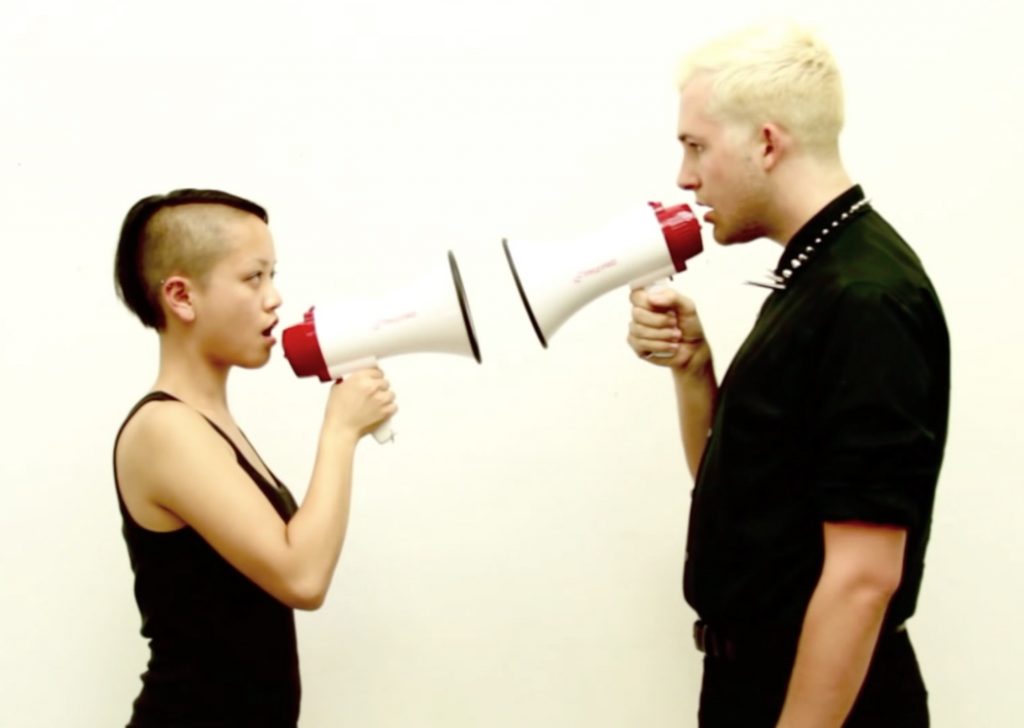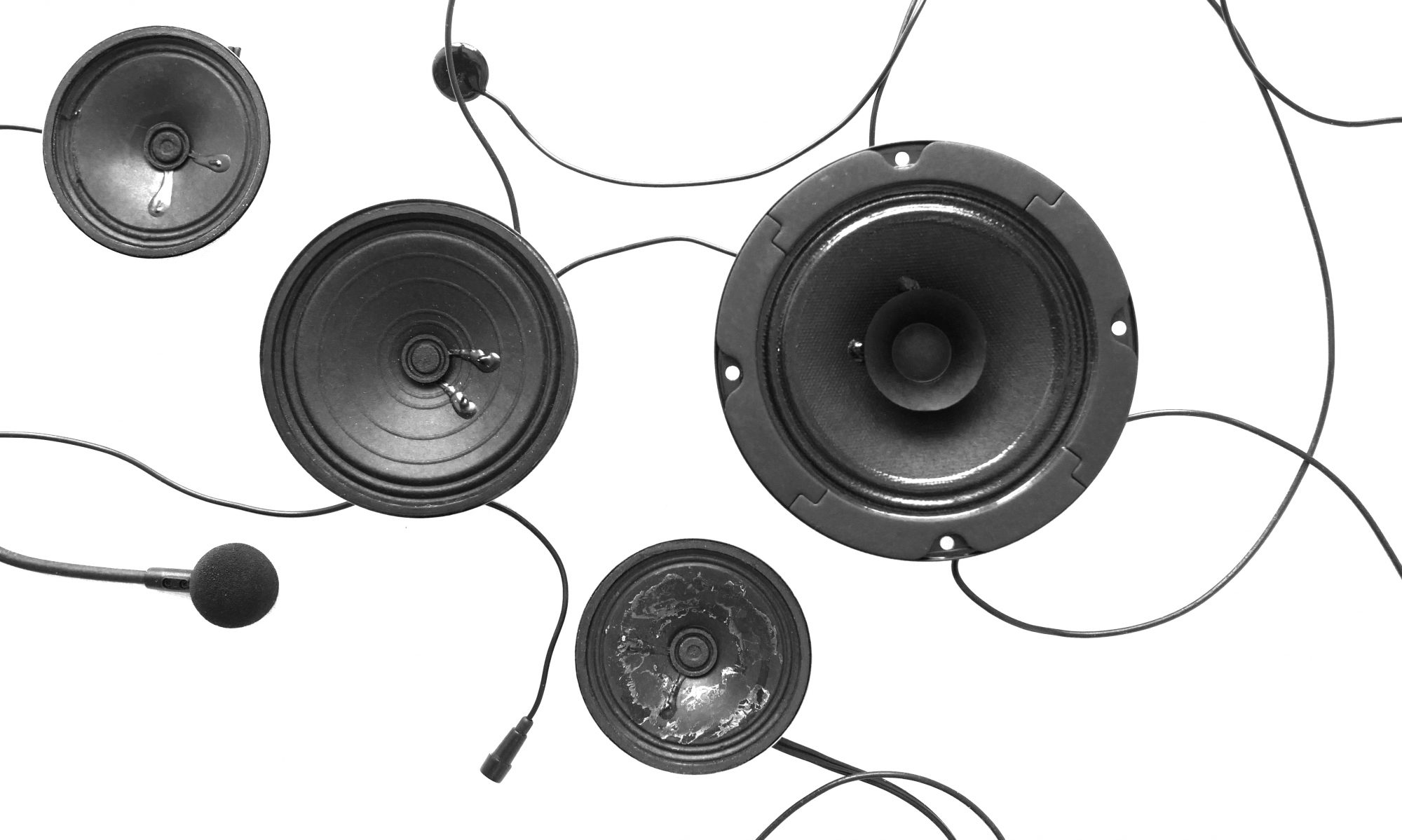
When you scream for someone’s attention you might hold both of your hands around your mouth to direct the sound waves leaving your mouth towards that person. This horn-like shape is used in many acoustical applications. Already in ancient Greek theatre masks were probably designed in such a way that they could amplify the actor’s voice. Various kinds of horn-shaped devices for voice-amplification have been developed since then. By the end of the nineteenth century, a variety of so-called speaking trumpets or megaphones existed. During this period many musicians were interested in obtaining louder sounds. Following the general interest during this area of obtaining louder sounds, the megaphone was also introduced on the stage. An in-depth overview of this development can be found in The era of megaphonics: on the productivity of loud sound, 1880-1930 by Tim Hecker. Early use of the megaphone on stage probably looked like this (this is a movie, not an original music performance. I could not find any footage of an original performance, but please let me know in case you do):
Soon these megaphones were replaced by microphone and loudspeaker systems during concerts. Further development of the horn resulted in a megaphone using electric amplification. A microphone, directly integrated into the horn or attached with an extra cable, is connected to a horn loudspeaker. An electric amplifier is now used to increase the volume level. This device was practical for ad-hoc and wireless amplification such as needed during demonstrations. In recent years several musical performances have been developed for these electric megaphones. I have a closer look at and listen to some of these.

Ken Ueno performing at the Jepson Center for the Arts (2018)
“If one does not consider the voice an instrument, then, the megaphone is my main instrument,” Ken Ueno writes on his use of the megaphone in his solo performances (see his text written about History of Breath). The megaphone is an “aspect of my performance practice which considers ways in which machines can function as prosthetic extensions of my voice.” To establish this connection between voice, megaphone and space, he has developed several special performing techniques. An example of such techniques is his use of a kind of tongue slaps. Their sharp attacks are very suitable to resonate in the performance space, a technique used in a variety of ways in the video documentation below. These clicks are amplified and sent into the space through the megaphone horn. By playing in different directions and different spots (something easily done with a portable megaphone) “the resonant frequencies of different locations in a space, means that architecture, too, could be read as harmonic structure.” In this way, he uses the megaphone as a means to connect sounds produced by his mouth to the surrounding space. The high-pitched sounds are combinations of feedback and ingressive singing. Soft feedback sounds occur by using the cavity of his mouth as a resonating space for the microphone of the megaphone. Ken is performing inside a circle of six snare drums which buzz when he directs the megaphone towards them. Their snares start to vibrate due to the sounds diffused by the megaphone. As Ken explained to me, “the snare drums produce snare rattles when I am direct the megaphone at them (proximity and amplitude are factors of activation).” A delicate filigree of different echoes is woven into the space.buzz when he directs the megaphone towards them. Their snares start to vibrate due to the sounds diffused by the megaphone. As Ken explained to me, “the snare drums produce snare rattles when I am direct the megaphone at them (proximity and amplitude are factors of activation).” A delicate filigree of different echoes is woven into the space.
Yun Ingrid Lee Das rote Sprachrohr (2012)
In Das rote Sprachrohr (2012) by Yun Ingrid Lee two performers face each other and both are holding a megaphone. Yun’s work is “concerned with how our filtered ways of sensing (via media technology) both limit and extend the ways we understand, categorize, archive, and compose the world and what it means to be human” (see the text on their website). In this work the megaphone can be regarded as the media technology, filtering and modulating the mouths of the performer. The megaphone is thus again a kind of extension of the mouth, as in Ken’s work, but this time it connects the two performers. More important, the mouths do not produce any sound, they only control the sound. The only sound heard is acoustic feedback between the two megaphones. The performance reveals very clearly how feedback comes into being: the mouth cavities form resonators in front of the microphone, and the horn of the megaphone is a resonator for the other megaphone horn.
As Yun writes in the score (which consists of four instructions, see below) by placing the mouth very close but with a little distance to the megaphone, feedback comes into being. The performers now have to separate (see instruction 3 in the score). They are connected through the feedback, using each other’s megaphone horns as resonators. But as soon as they move too far from each other, the feedback will stop and the performers repeat the same procedure. By repeating the same action several times, another characteristic of feedback becomes audible: although the actions are each time the same, the feedback will answer differently since every small change in mouth position and distance will influence the sound. What especially captivates me in this intimate performance is how the performers visually move apart, but aurally still “touch each other” while moving away from each other.

Jagoda Szmytka sky-me, type-me (2011)
Whereas the megaphones used in Das rote Sprachrohr need a microphone that is integrated into the megaphone itself, for her piece sky-me, type-me Jagoda Szmytka asks for megaphones with external microphones. The piece is composed for four singers and four megaphones. In the score, many different forms of megaphone playing are notated. The distance between the mouth and the microphone of the megaphone is notated precisely. Also, Jagoda is using different kinds of playing for the microphone itself. The microphone is tapped, covered by a hand, and the hand is used as a filter for the sound of the microphone:

Another important element of the piece is the noise produced by switching the megaphones on and off, and of course the voices of the performers themselves. As the title already suggests, the piece is about contemporary forms of communication, such as skype, zoom, text messages, and all kinds of other forms of non-face-to-face communication. What sounds during the piece seems to be all the odds and ends during these conversations one usually tries to avoid. Typing sounds, long noisy breaks, broken sentences, incomprehensible utterances, inexplicable laughter, and distanced voices give me the feeling of being lost in one of the contemporary forms of audio communication. But this time I can enjoy all the failures and glitches of these forms of transmission since I only have to listen and do not have to respond to anything. As Jagoda told me, sky-me, type-me was composed for singers and a vocal quartet gave a premiere of it. However, it turned out that each part is performable by any music performer, regardless of whether someone received voice training. This piece is from 2011, but since many of us have been corresponding online very often during the last year and a half, it might even have become more topical for many of us.
Marcel Zaes Setting #26 (2020)
One of the last events I took part in before the pandemic, was this performance of Marcel Zaes‘ Setting #26 in Chicago in February 2020. Marcel describes his series of works Setting as living installation pieces. At the moment, there are 27 of these “Settings” and they use different kinds of objects, such as phones, plastic bags, and electronic metronomes for producing sounds. Several of them use megaphones. They are ideal for these kinds of performances since they can be easily carried around, each performer has their personal sound system with a microphone and loudspeaker, and you can connect an external sound source to be amplified through the megaphone. As Marcel describes in the score of Setting #26 this is “a mediated performance with a found stage, performers with sound-making phones and megaphones, directed by an instruction score”.
The found stage for this performance was an empty parking lot in Chicago, and we performed during a late (and very cold) evening. The main instructions for the performers in the Settings are often just some sentences. In Setting #26 these were:
When the audio is silent, the performers stand still, while they keep the
megaphone up, in front of their chest. Once sound is playing, they first choose a (new)
direction, then they slowly walk in a straight line in the chosen direction.
Every performer has a different sound file, so the seven performers in this piece will all move at different movements. Due to these minimal instructions, the actions of the performers are very consistent and result in a sonic sculpture of always slightly different but very similar sound and movement combinations. When taking part in Setting #26 the megaphone seemed to be the musician, telling me when to move and when not. The final format of these performances is never the performance itself, but the video documentation of the performance. While watching and listening to the performance, I watch a happening from somewhere else.
Thank you for answering my questions, Ken, Yun, Jagoda and Marcel!
